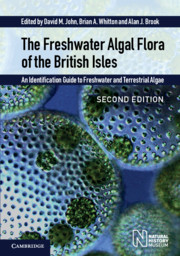 The Freshwater Algal Flora of the British Isles
The Freshwater Algal Flora of the British Isles Published online by Cambridge University Press: 12 January 2024
Second edition
It is now nine years since the first edition of this Flora was issued and it is no longer available. Apart from that, major changes have taken place in the classification and taxonomy of the algae. Lastly, there are some 200 verifiable additions to the flora and increased knowledge of various aspects of the ecology and distribution of many taxa. Clearly a new edition is needed, and the editors and contributors are to be congratulated on their conclusion of a major task. They have kept to what can be seen with a light microscope. This does make the identification of some species impossible (e.g. in the genus Mallomonas), but the vast majority of freshwater algae can still be identified in this way.
The results of investigations using electron microscopy and of phylogenetic studies have caused a major revision of the Chlorophyta, although there are some still unresolved problems, notably in Klebsormidium, a cosmopolitan genus containing some of the commonest soil algae. Considerable clarification has been made in the equally common aquatic genus Scenedesmus, pictures of which are legion. The chapter on Cyanobacteria (Cyanophyta) has been enlarged and partially revised and is an especially valuable overview based on the author’s great knowledge of the group. A welcome addition is the inclusion of ‘colourless’ (non-photosynthetic) Euglenophyta. ‘Colourless’ Cryptophyta and Dinophyta are also included. The chapter on Desmids is significantly enlarged; yet less than half of the 900 British species are included. Very helpful additions are the pictures illustrating the common terms used in the description of these algae. Another welcome addition is the short yet masterly chapter on cultures of algae.
Despite the additions made, the new edition is just over 170 pages longer than the first. The CD of that volume is replaced by a DVD which includes a variety of images and articles. The photo catalogue of algae and their habitats is considerably enlarged (now over 1400 images) and the coded checklist of freshwater and terrestrial algae has been brought up to date. There are stunning pictures of desmids along all three axes. The pictures of Vaucheria are also to be highly commended.
The edition is a fine successor to the first and is likely to have an even larger circle of users.
J.W.G. Lund FRS
August 2010
To save this book to your Kindle, first ensure [email protected] is added to your Approved Personal Document E-mail List under your Personal Document Settings on the Manage Your Content and Devices page of your Amazon account. Then enter the ‘name’ part of your Kindle email address below. Find out more about saving to your Kindle.
Note you can select to save to either the @free.kindle.com or @kindle.com variations. ‘@free.kindle.com’ emails are free but can only be saved to your device when it is connected to wi-fi. ‘@kindle.com’ emails can be delivered even when you are not connected to wi-fi, but note that service fees apply.
Find out more about the Kindle Personal Document Service.
To save content items to your account, please confirm that you agree to abide by our usage policies. If this is the first time you use this feature, you will be asked to authorise Cambridge Core to connect with your account. Find out more about saving content to Dropbox.
To save content items to your account, please confirm that you agree to abide by our usage policies. If this is the first time you use this feature, you will be asked to authorise Cambridge Core to connect with your account. Find out more about saving content to Google Drive.